Team collaboration strategies to save projects from failing are all the rage these days. As these strategies disrupt the way you work and the results you get, experts tell us they believe in following their own ways that work best for them to save their projects from failing.
Table of Contents
- Here are their views on team collaboration strategies:
- 1. Sandeep Kashyap says you need to communicate the bigger picture
- 2. Blessing Abeng believes in going far as a team
- 3. Josh Steimle’s idea of team collaboration strategy
- 4. John Rampton thinks that cloud-based platforms and their responsiveness are the way to go
- 5. Thomas Oppong says strong connections matter
- 6. Dino Pacella emphasizes on ‘CCR approach’
- 7. Cory Warfield talks about shared vision
- 8. Nicholas Cole believes small issues should get fixed all along the way
- 9. Fabio Marrama doesn’t believe in leaving the team collaboration strategy to chance
- 10. Tim Hughes votes for social platforms
- 11. Amer Kayyal believes in team spirit
- 12. Nathan Chan says Kanban system is the savior
- 13. Jacob Rogelberg says the best ideas don’t come from the highest paid person
- 14. Ted Rubin affirms the need for one-stop communications platforms
- 15. Alex Doman needs a mastermind team
- 16. Igor Rutsky talks about having a robust strategy
Here are their views on team collaboration strategies:
1. Sandeep Kashyap says you need to communicate the bigger picture
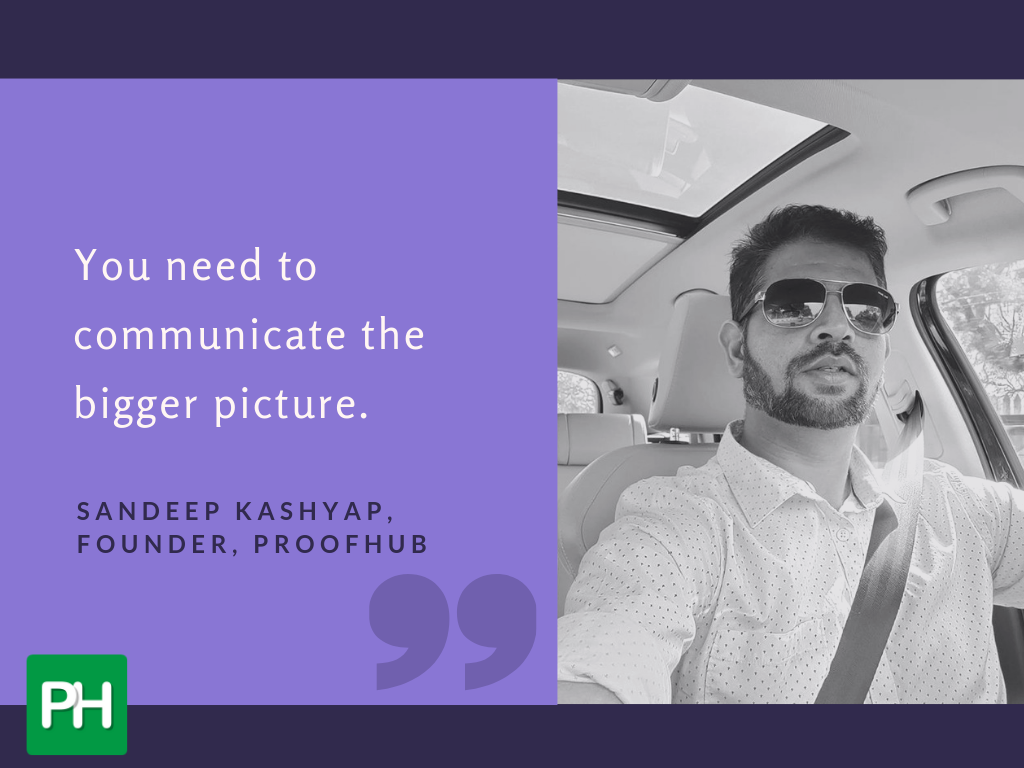
Sandeep Kashyap is the Founder and CEO of ProofHub — a leading project management and collaboration software. He’s one person always on the lookout for innovative ideas about filling the communication gap between groups, teams, and organizations. You’ll find him saying, “Let’s go!” instead of “Go!” many times a day.
Read on his views:
I don’t like it when you don’t feel free to communicate in the team – the whole team effort to finish the project successfully goes in vain,” I have heard this a lot of times. Teamwork and communication are important. Most of the times, one of the notable reasons projects fail is not having transparency in the team. I’ve observed the more collaborative the environment is the more does the team naturally feel a part of something bigger than themselves. I vouch for openness.
I often emphasize how everyone in the organization is on a mission and the mission needs to be accomplished: we all are responsible for that. “Roger that!”, “Mission accomplished!”, “Mission abort!”: all these phrases make work fun at times. However, collaboration is not only encouraged through team building activities or let alone phrases. We sure have our share of those too, but the technology we use to communicate plays an important role too.
That’s where ProofHub comes in the picture. If this is a world where the art of communication is the language of leadership, ProofHub is built on the premise to fill the communication gap between teams.
Every single feature in ProofHub is thought out well enough to help people work together and rather celebrate their work together. How difficult could it be to finish a project successfully when you can move tasks through various stages right on the Kanban boards and have complete transparency over who is doing what and when? If not that, how tough could it be to proof an image and give feedback for specific regions using markup tools? Well, not only my team but also our customers tell how their teams feel part of something bigger using ProofHub. The best way to achieve project success is to equip each team member for an active participation in the group dynamic and you’ll see the transition from an individual to a collaborative mindset.
2. Blessing Abeng believes in going far as a team

Blessing Abeng is a multi-faceted entrepreneur driven by the need to create lasting solutions to key problems faced by individuals, and SMEs.
Her views on a team collaboration strategy that he truly believes in:
I have often believed the quote that says “If you want to go faster go alone but if you want to go far go as a team”. I think this holds true because we all bring our uniqueness to the table and our ability to find cohesion, synergy, and rhythm is our work makes it easier to dance.
We have weekly runs, highlighting what we accomplished the week before, what we hope to accomplish in the current week and what we’ll need to make it happen. This helps us know what we are all working on and makes it easier for us to help each other and understand how our actions affect the overall work and other team members’ duties.
We care about excellence and we take ownership. Majorly because team members find the intersection between their personal goals and the business vision. It makes it easy for us all to be motivated. We use collaboration tools as well and take monthly and quarterly training to help improve our skills (technical and soft skills). Most importantly, we talk. We share information about our personal goals, our problems and generally just ask each other questions. We are always willing to help each other.
We understand that efforts are only recognized when results are there to prove those efforts. So we do our best to never make excuses, and we believe nothing is impossible. Our team collaboration strategy starts with every individual’s mind. The mind is capable of anything if you let it. This is what makes our team so strong.
3. Josh Steimle’s idea of team collaboration strategy
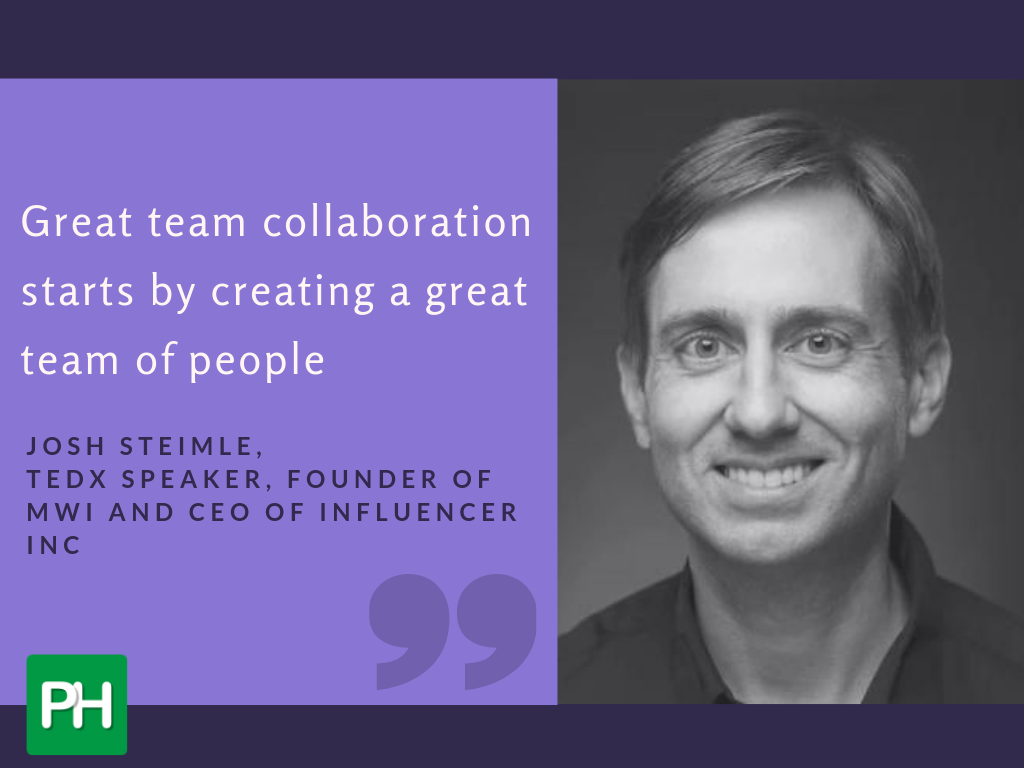
Josh Steimle is an author, speaker, entrepreneur, and executive coach. He is also a TEDx speaker, founder of MWI and CEO of Influencer Inc.
Here’s his comment:
Although I heard it 20 years ago, something I learned while studying technology at university has stuck with me — most technology implementation projects fail, and most of them fail because of people, not the technology.
Effective team collaboration doesn’t depend on great technology. Technology can facilitate effective collaboration, but it won’t create or sustain it. Great team collaboration starts by creating a great team of people who have the right experience for the job, and who also are adept at working with others. The next key is to make sure the team communicates effectively, and often. Without frequent, clear communication it doesn’t matter how great the team is in every other way, because they will fail. This is where technology can be valuable in assisting with effective communication, but it’s the people who either use the technology or don’t, and there is no difference between the best technology and the worst if it isn’t used.
Finally, every great team needs a leader. Someone needs to be ultimately responsible for communication, technology, and collaboration. Teams occasionally thrive in the short term without strong leadership, but long term success demands effective leadership.
4. John Rampton thinks that cloud-based platforms and their responsiveness are the way to go
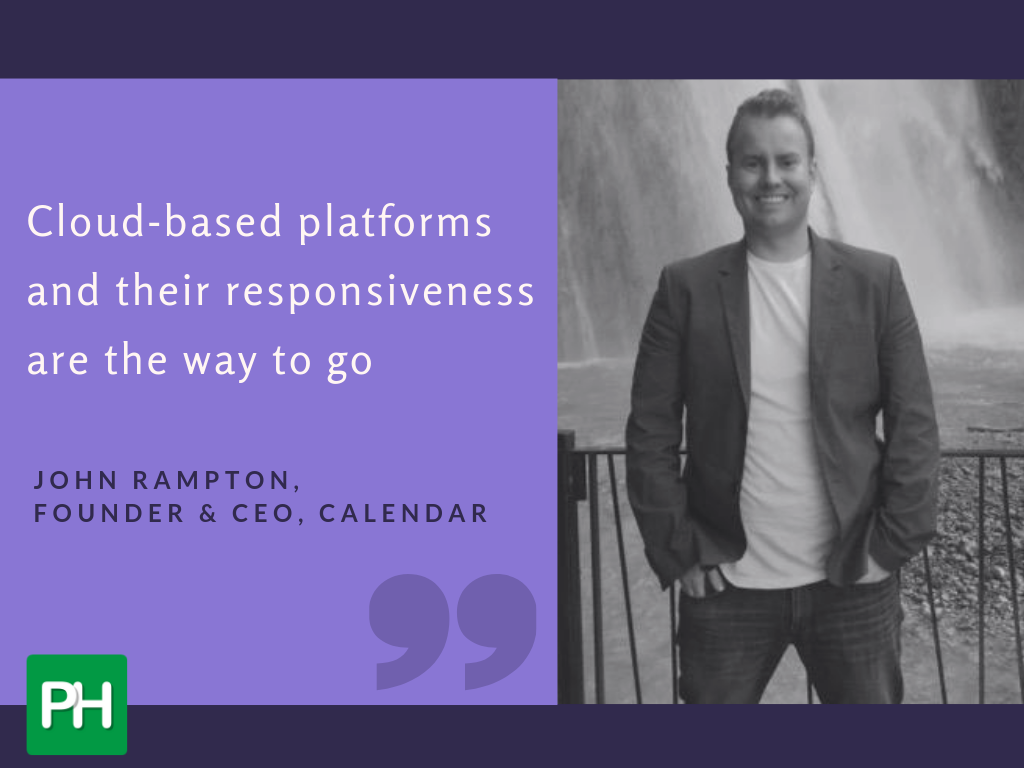
John Rampton a serial entrepreneur, investor, online marketing guru, author, speaker, connector and startup enthusiast. He is the founder and CEO of the productivity solutions company Calendar and the online payments company Due. He was named #2 on Top 50 Online Influencers in the World by Entrepreneur Magazine and blogging Expert by Time. He currently advises several companies in the San Francisco Bay area.
Here are his thoughts:
Our team collaboration strategy focuses on working within cloud-based platforms that help us interact from anywhere in the world. With a team that is scattered across the globe in different time zones, things can go wrong. However, we’ve kept projects from failing because we have access to each other through these platforms where we can answer questions, send files, and offer suggestions at any time of the day or evening without too much effort. That keeps us all moving forward rather than failing because there could be up to a 12-hour time difference between team members.
Beyond technology, though, it’s also been important to ensure everyone has been trained to use these platforms and understands how their responsiveness can help other team members be successful at their part of the project. Since enacting this approach to the collaborative process, we’ve been able to keep all projects on schedule.
5. Thomas Oppong says strong connections matter
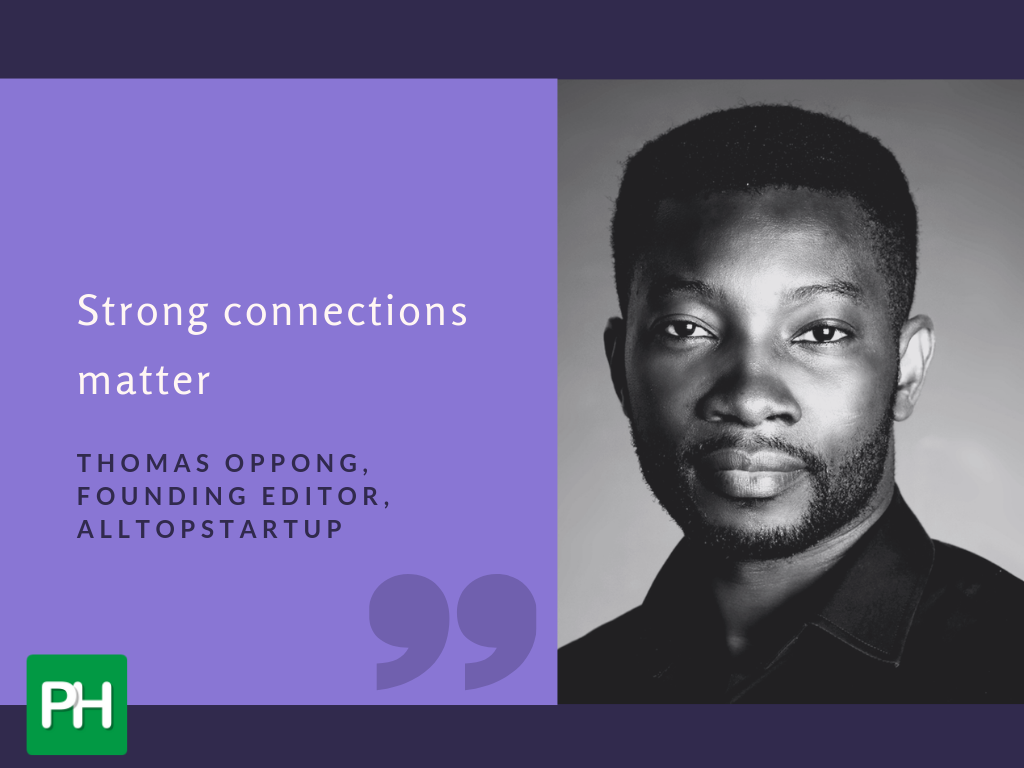
Thomas is the Founding Editor at Alltopstartups.com. He is a Columnist @Inc. Magazine and has been featured at Forbes, Entrepreneur and Business Insider.
He explains his strategy down here:
Successful businesses thrive on collaboration. Effective team collaboration is much more than people ‘working together’. The best performing teams are built on strong connections, trust, and better relationships. Successful businesses work towards a bigger goal. To bring out the best in any team, company vision, mission, and project goals should be clearly communicated to employees. Inspire team members with a clear reason to be a part of the project. The more compelling and exciting the overall goal, the easier it is to motivate team members to actively contribute their best ideas to help the project succeed. People work better when they know and feel they’re a part of something bigger, and that their effort, no matter how small, will contribute to the success of the business.
Once the vision and purpose of the project are clear, encourage full participation by establishing specific, measurable, attainable, realistic and timely goals. Assign roles according to individual strengths to empower each member of the team. Highlight team members’ core abilities and what they are bringing to the team. Appreciate their skills. Team members tend to hold back if their unique set of skills are not being used or recognized by leaders. Members are likely to share ideas freely if they are encouraged to use their strengths fully without judgment. In a collaborative environment, successful teams rely on each other to complete projects.
6. Dino Pacella emphasizes on ‘CCR approach’
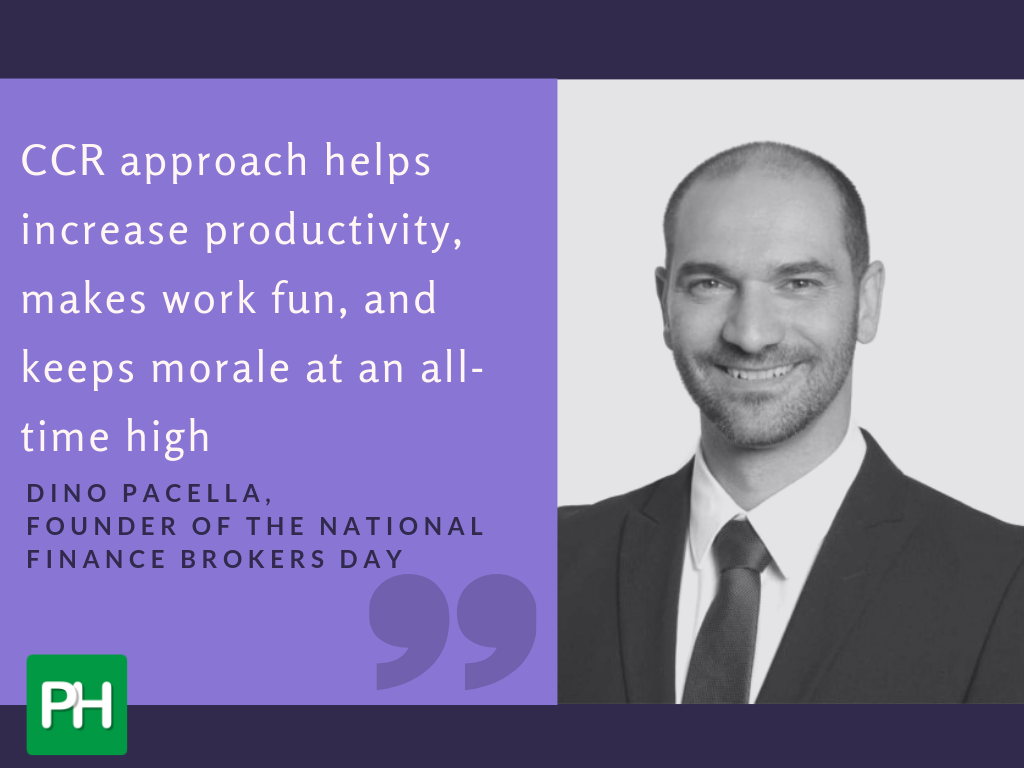
He is the Founder of the National Finance Brokers Day, established in 2015 to build awareness of the broking industry throughout Australia and help educate consumers on the advantages of dealing with a broker along with the full-service proposition that these professionals bring to the marketplace.
Here’s his point of view:
When collaborating with team members on projects to help grow and increase our presence we always work towards the CCR approach. Communicate with each other, be sure to be open and willing to hear others view with the safety net to challenge and push the boundaries of innovation and reasoning. Secondly is the ability to Compromise as this is instrumental to success within all collaborations. Lastly, these two above C’s are overarched with the final layer of Respect. Show your colleagues that you value their opinions and that you appreciate their efforts even if you may not agree with them all the time. This CCR approach helps increase productivity, makes work fun, and keeps morale at an all-time high.
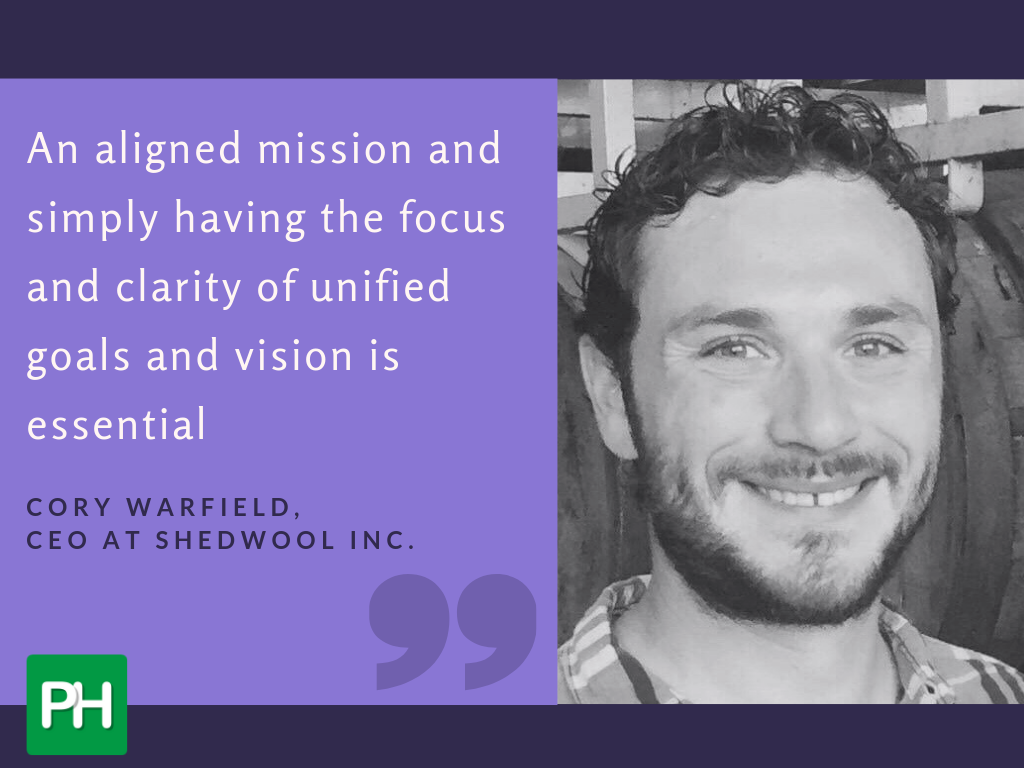
Cory spent 20 years working in restaurants starting as a dishwasher and working up to corporate leadership (working every station in between) before starting ShedWool – a web- and mobile-app solution solving the problem that plagued his careers and everyone else is n the hospitality: scheduling and labor.
Here are his thoughts:
Communication is everything, so having a robust team communication tool such as Slack is imperative. It’s also critical to know what others are working on and to ensure that others know what you’re working on as well. In my experience building teams and growing companies, an aligned mission and simply having the focus and clarity of unified goals and vision is essential. It truly does all boil down to communication and shared vision. Incidentally neither is effective without the other: communication without vision is frivolous, and vision without communication is ineffective.
Proper team communication tools that show threads with collapsible replies that make it possible to actually review previous messages, shareable insight into action-items in a format like Trello, and a good CRM are all imperative, and, when used properly, become a team or organizations’ secret weapon. The digital resources exist to ensure proper communication and promote teamwork, so it’s simply a matter now of identifying what works best in your current team and is best suited for your needs. A few things to watch out for are lone wolves, people who aren’t forthcoming with what they’re working on and clash of personalities. Often leadership uses scare tactics of fear and loss, and this never fosters goodwill or a winning mentality.
It’s often overlooked that business teams are teams just like sports teams, and need an altruistic yet disciplined leader, a coach, and to cover all positions. All sports teams have strategies for defense as well as offense and show up to win. Having the proper tools is paramount to success and winning. No sport with more than one person competing against more than one person can or has ever won without practice, tenacity, communication, shared vision, and the proper tools.
8. Nicholas Cole believes small issues should get fixed all along the way
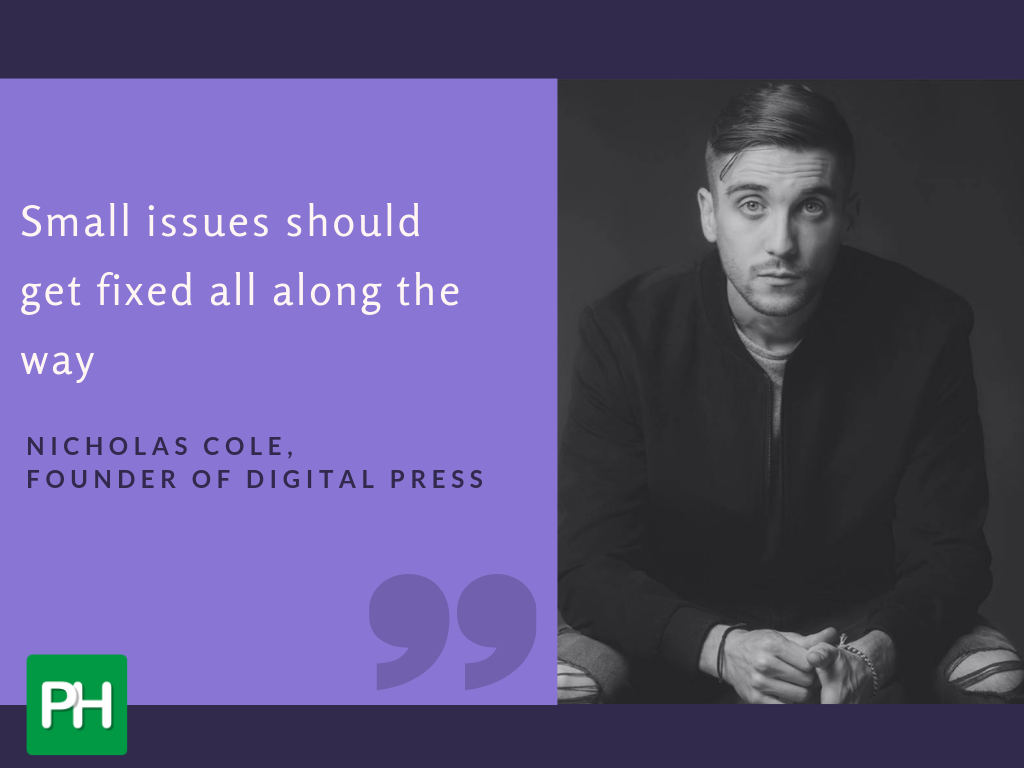
He says:
Back before I was an entrepreneur, I was actually a bodybuilder — and the first viral article I ever wrote on the Internet was about the massive transformation I went through. But between me and all the guys I lifted with on a daily basis, we used to have this saying: “Failing to prepare means preparing to fail.” Every night, we would prep our meals for the following day. Every Sunday, we would go grocery shopping to load up on food for the week. And every day at the gym, we would stretch and go through a routine of exercises before getting into our core lifts. I lived my life this way for almost 7 years straight, and it taught me endless lessons about preparation, discipline, persistence, and the undervalued art of routine.
When I ended up injuring myself in 2016, I quickly realized I was going to have to give uplifting (at least, with that intensity) for the rest of my life. I herniated a disc in my neck, and even a year later couldn’t get back into the gym. But this ended up being a blessing in disguise, and allowed me to spend more time, energy, and focus on the thing I ultimately knew I loved more, which was writing.
Between 2016 and 2017, while in physical therapy and trying to recover from this serious neck/back injury, I became not only one of the most popular writers on the Internet with tens of millions of views on my work, but I ended up launching my first company, called Digital Press: a thought leadership branding and marketing agency for founders, CEOs, speakers, etc. In less than 12 months, we scaled to over 15 full-time employees, 50+ clients, and 7-figures in revenue.
Whenever I tell that story, a lot of people assume it “all happened at once.” And in many ways, it did. But what people don’t see are the 10 years I spent writing on my own, mastering my craft and my knowledge of the space, before launching a written content agency. The success that happened didn’t just “happen.” It was actually the result of years and years of preparation, whether or not I had known it at the time.
I believe this is one of those fundamental truths in business that doesn’t get discussed very often, which is this idea that who you are today creates what you become tomorrow. And for the most part, when an individual or a team or even an entire company starts experiencing massive issues, or projects “fail,” it’s not because something happened abruptly — but rather, many small things failed all along the way, weren’t fixed, and then culminated into one larger failure. Which is why, in order to be successful over the long term, “success” has far more to do with preparation and prevention, rather than knowing how to run fire drills in a moment of panic. And it should be every team’s #1 priority to look for ways to improve, refine, iterate, and solve problems all along the way, opposed to waiting for a small problem to turn into a bigger problem and ultimately ruin a project altogether.
“Failing to prepare means preparing to fail.”
9. Fabio Marrama doesn’t believe in leaving the team collaboration strategy to chance

Fabio Marrama is considered one of the top young up-and-coming business and marketing professionals in Southern Ontario, Canada. He had been creating an impact in the communities he served having placed Top 10 in Canada back to back at the Canadian National Enactus Entrepreneurship Challenge, representing Niagara. He helped launch the very first Human-Centered Design Thinking Course at Ryerson University, in partnership with The Ryerson Entrepreneur Institute. He has been mentioned in top publications like Forbes, Social Media Examiner and TheSpec, he’s guest-appeared on multiple Top 100 Podcasts on iTunes and is endorsed by global influencers like Jay Shetty as a “Must-Follow” on LinkedIn.
His thoughts on a team collaboration strategy are as followed:
A thriving and vibrant high producing collaborative team starts and ends with a solid process. Period. When you leave your team collaboration strategy to chance – projects can fall apart. Cultures can crumble. One of the highest performing team structures I’ve ever been a part of was one that executed the methodology of “Design Thinking” with daily team reflection.
The process of Design Thinking takes you into unknown and sometimes uncomfortable territory for many because not all teams execute each project through a process. Members of a Design Thinking based team need to be open-minded, inquisitive, collaborative, adaptable to change and allow their assumptions to be challenged by others in a safe environment. When those expectations are set, it leads to massive transformation on projects and extreme trust and comradery built amongst the team when results are achieved together. This method consists of 5 phases — Empathize, Define, Ideate, Prototype, and Test. The design thinking method has become increasingly popular over the last few decades and was a key driver of transformation in the success of many notable organizations such as Google, Airbnb, and Apple. Design thinking improves the world around us each and every day because of its unique ability to create ground-breaking solutions in a positively disruptive and innovative way and brings teams together to collaborate. Design thinking is more than just a process. It’s an organizational way of life that not only saves projects from failing – but creates sustainable and repeatable results.
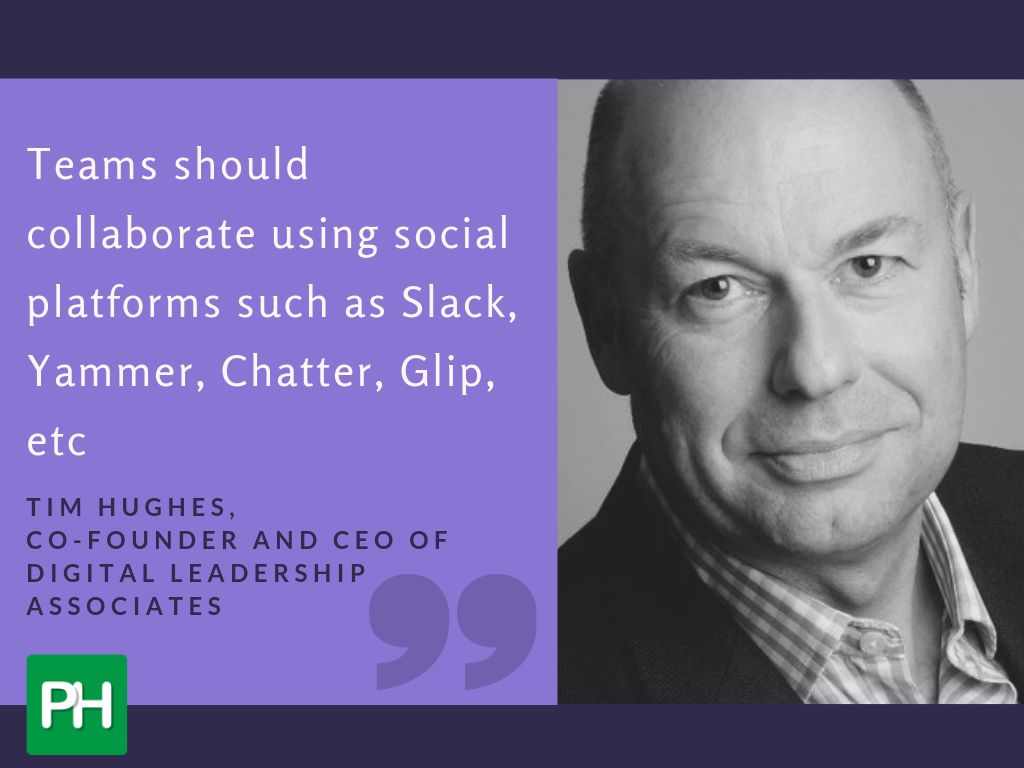
Tim Hughes is the co-founder and CEO of Digital Leadership Associates and co-author of the bestselling books “Social Selling – Techniques to Influence Buyers and Changemakers” and “Smarketing – How To Achieve Competitive Advantage through blended Sales and Marketing”. He is currently ranked Number 1 by Onalytica as the most influential social selling person in the world.
He says:
From day one of any project, a team needs to be able to collaborate using social platforms. I’m not talking about Facebook, Twitter and LinkedIn, etc but using social platforms such as Slack, Yammer, Chatter, Glip, etc.
Social platforms will allow team(s) to collaborate regardless of time zone and geography. In fact, research shows that using social internally can increase your employees efficiently by 25%. That’s 25% more people in your company for free. If you are a 100,000 employee company that’s 25,000 employees for free or an 8-person company that’s 2 employees for free.
Social platforms can be used within a project for cascading information or changes, for inter-project members or even inter-project team collaboration. You can invite, all sides of the project, client, team, partners. There is no need to trawl through emails, as the conversations and there fully and be audited.
New starters can also be accommodated quicker as all you have to do is add them to the conversations and they can see the discussions.
11. Amer Kayyal believes in team spirit
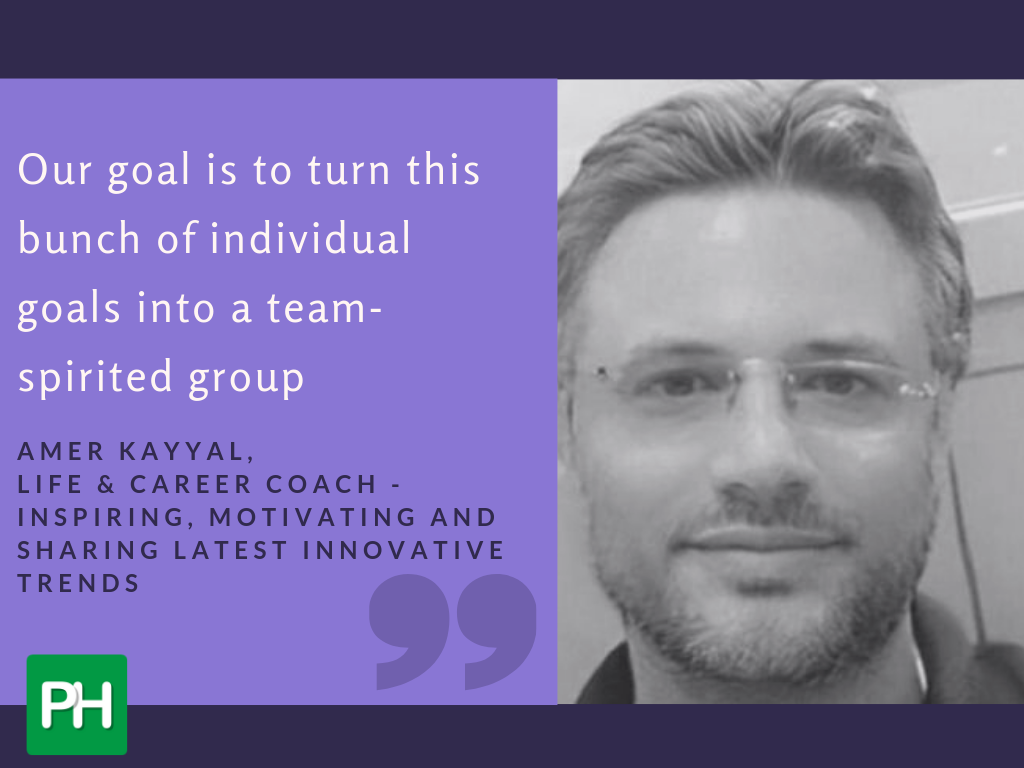
Amer Kayyal is a Senior Manager with over 20 Years’ experience in Overall Business Management & Development , Retail Sales Management, Distribution Management (All Channels Key Accounts , Key Retailers & Whole Sales). Dynamic and accomplished professional with extensive experience in Marketing, Customer Service and Sales. Hands-on experience in employee training, preparation of work schedules and assignment of duties to team members, setting marketing & sales goals and business development.
Here are his thoughts:
How to improve your team collaboration discovering the right team collaboration strategies are important for your project’s success. If everyone only works toward their individual goals, they can end up doing overlapping tasks and competing with each other. Your goal is to turn this bunch of individuals into a team-spirited group. From doing team games to using online collaboration tools like Teamweek, there are many ways to encourage team-oriented behaviors. Start by modeling the behaviors you want and reward team members who collaborate effectively. Through collaboration, your team will be able to accomplish far more together than they are capable of individually.
12. Nathan Chan says Kanban system is the savior
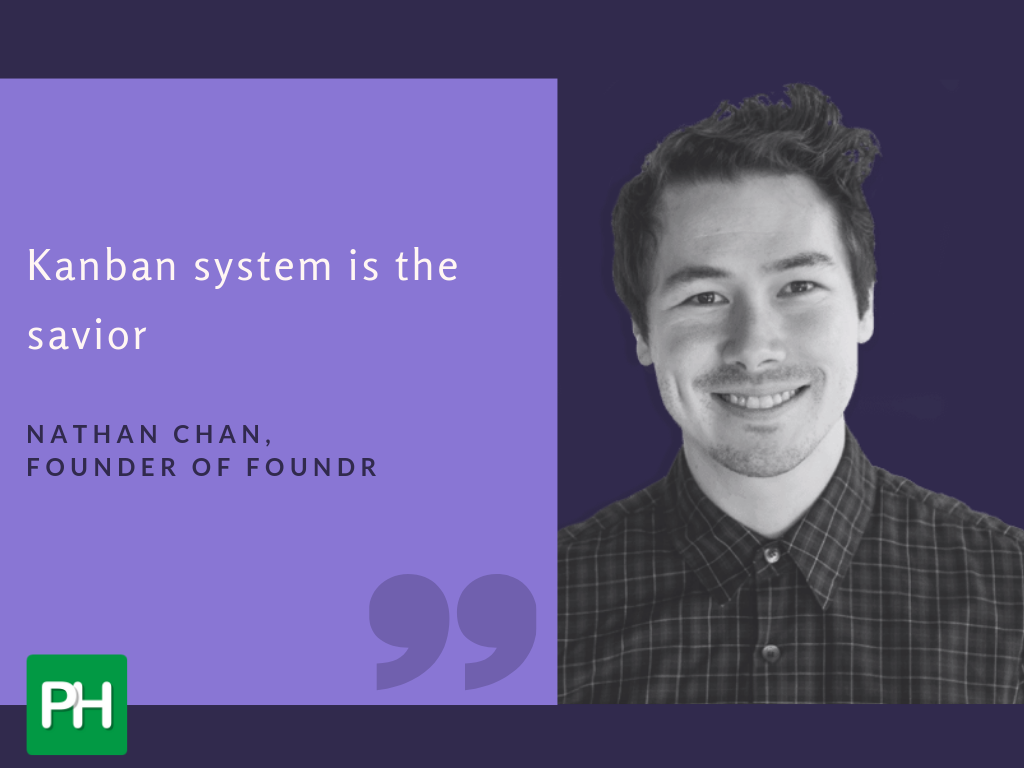
Nathan Chan don’t work. He is on a mission to building a house hold name entrepreneurial brand that impacts 10’s of millions of people on a weekly basis with our content at Foundr Magazine. He believe life is too short to do work you hate. With a passion for entrepreneurship and people he created Foundr, a global media and education company that produces magazines, and online courses for entrepreneurs. Millions of people consume Foundr’s content every month, and our magazine covers have been blessed by the likes of Richard Branson, Arianna Huffington, Mark Cuban, Tim Ferriss and many more.
Here’s his point of view:
Using the Kanban system for projects from experience ensures they are often on track and delivered on time. Using a daily standup is critical for getting team buy-in and having effective lines of communication. Also, making sure the project has an owner and that person is responsible for its success.
13. Jacob Rogelberg says the best ideas don’t come from the highest paid person
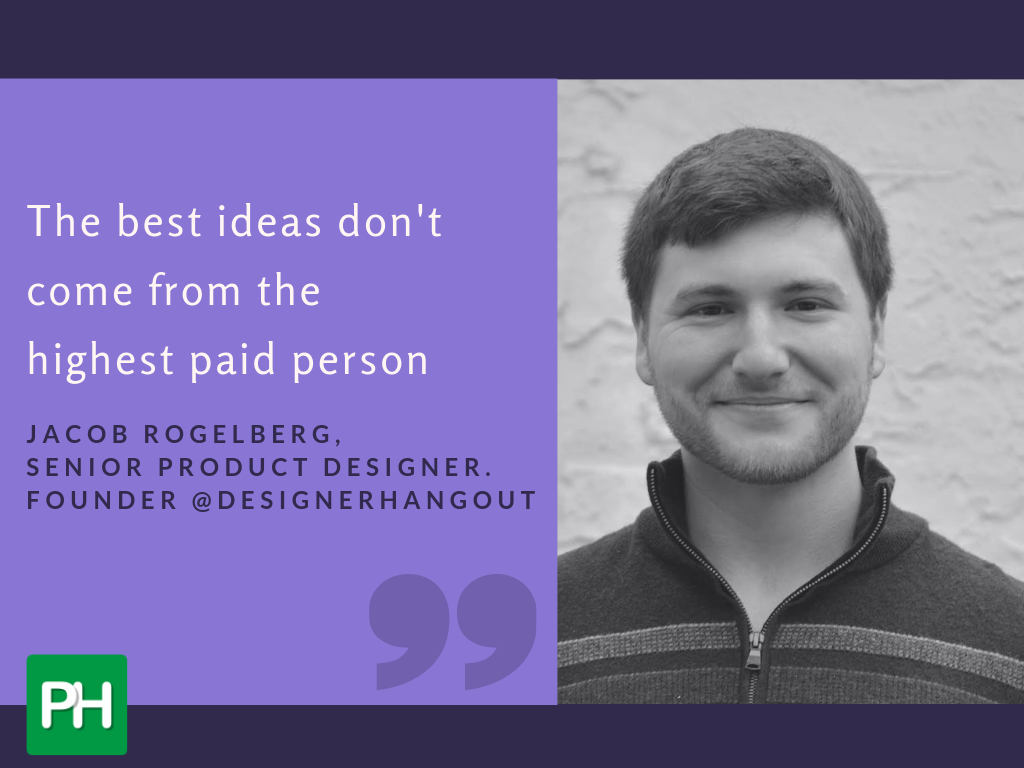
Jacob runs the world’s largest real-time UX design community Designer Hangout and is building Spacejunk to accelerate crypto awareness and adoption via great ideas, research, and community. As a Product Designer in the blockchain space, Jacob helps systems make sense to the people who use them.
His views:
We’ve all been there. You’re in a big meeting with folks from various departments all gathered in a room to brainstorm and agree on a direction. Some people dominate the conversation. Sometimes it’s the loudest person and sometimes it’s the highest paid person. After all, how can you question the assumptions of people who sound right or receive the largest paycheck?
Try this. Instead of letting the conversation flow naturally leaving some afraid to speak up, hand out sticky notes to each person in the meeting. Ask each person to write down their thoughts on the problem at hand. Do this in silence and give people about five minutes to complete the task. After five minutes, one by one, give each person a chance to share their ideas and put them up on a wall or whiteboard. After all of the ideas are up, as a team, you can start grouping them with a technique called Affinity Mapping.
That’s it! You just gave everyone in the room a chance to weigh in on the conversation. Plus, everyone likes sticky notes. It feels collaborative and after getting all of your ideas up on the wall, it really gets the creative juices flowing.
14. Ted Rubin affirms the need for one-stop communications platforms
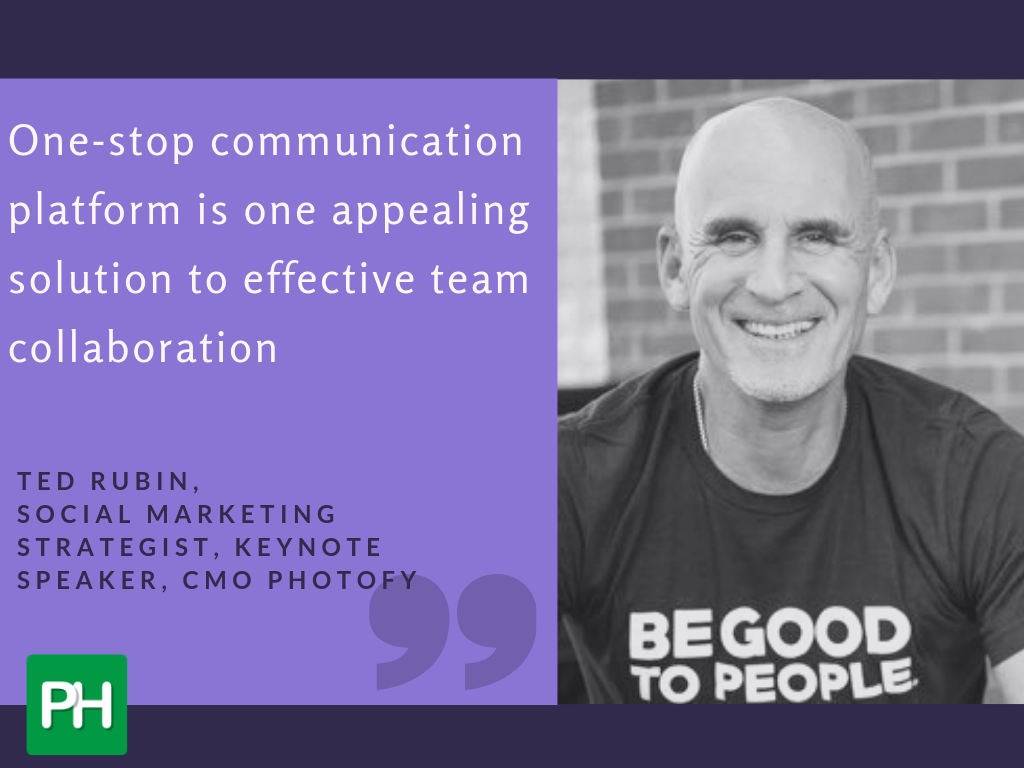
Ted is a leading Social Marketing Strategist, Photofy CMO/Advisor, MC/Host of Brand Innovators Monthly Summits… Speaker/Author/Provocateur. Many people in the social media world know Ted for his enthusiastic, energetic and undeniably personal connection to people. Ted is the most followed CMO on Twitter according to Social Media Marketing Magazine; one of the most interesting CMOs on Twitter according to Say Media, #13 on Forbes Top 50 Social Media Power Influencers, and number #2 on the Leadtail list of Top 25 People Most Mentioned by digital marketers. ROR is the basis of his philosophy… It’s All About Relationships! Return on Relationship, ROR, #RonR, is the basis of his philosophy… It’s All About Relationships!
Here are his thoughts:
For many younger employees who have entered the job market in the last decade, working remotely is simply a way of life. The technology is there to make it happen relatively seamlessly. The flexibility of working remotely is great, and it removes some of the common geographical barriers from finding the right job. But it’s not perfect.
As many employees in their 20s and early 30s have learned, working remotely can limit the opportunities for collaboration and mentorship that come more naturally when you’re working in an office surrounded by more experienced employees. It’s a serious challenge for companies with a large remote workforce, and we need to be looking hard at ways to deliver those crucial experiences to remote employees.
Some very well-known brands – including IBM, a very early adopter of telecommuting – are bringing some of their remote workforces back to the office, according to NPR. Because employees are looking for more opportunities for collaboration and mentorship, calling employees back to the office may seem like a natural fit. However, while the shift may be an appealing solution for some employees, it’s not going to be a good fit for everyone. Mix in the fact that telecommuting is definitely not going anywhere as a concept, and it’s easy to see why we need to find different ways for remote employees to collaborate with their colleagues.
The mentorship and collaboration problem for remote employees ultimately comes down to communication. When you’re in an office or store working with a team of experienced people, asking a more experienced person for advice is often as simple as taking a walk around the corner. People are with you all the time. You can reach who you want, when you want, without putting in too much thought into the logistics. It’s much easier to ask for help or work together on a project when you don’t have to jump through hoops just to make contact.
In theory, communicating with colleagues remotely shouldn’t be that hard. We have social media, instant messaging, and countless apps to make that happen. But that’s also part of the challenge. With so many ways to communicate, finding the right person on the right channel at the right time is often much easier said than done.
Effective, one-stop communication platform is one appealing solution to this challenge because they make it so much easier for remote employees to facilitate conversation and collaboration. If you have an important question for a trusted mentor, it’s much easier to find your answer with a consistent, reliable communications platform. If you’re trying to collaborate on a project, then the last thing you need is to be struggling to make contact with your team.
Dynamic Signal is one communications platform doing great work with a robust platform for internal comms and for employing an employee advocacy component. Slack of course leads the way in daily and project collaboration. The idea is to facilitate communication between remote employees in a way that allows them to interact naturally, with very strong support for mobile devices. It may not be the same as strolling over to the next office, but being able to pull out your phone and engage immediately makes it much easier for today’s employees to work together. Very important to keep in mind platforms can offer great tools, but the human attitude and perspective component is what will drive the collaboration mindset.
The good news is that remote employees, and those on site, really want to learn and engage, as long as they have the tools to do so. If you provide the means, employees will seek out opportunities to learn, grow, create, and deliver on goals with their peers. So, as always, this whole collaboration drive by companies starts at the top and needs to be fostered at every level. Build a community mindset, helping and supporting the team, and the rest will flow. A Network Gives You Reach… But A Community Gives You Power! Networks Connect… Communities Care! #NoLetUp!
15. Alex Doman needs a mastermind team
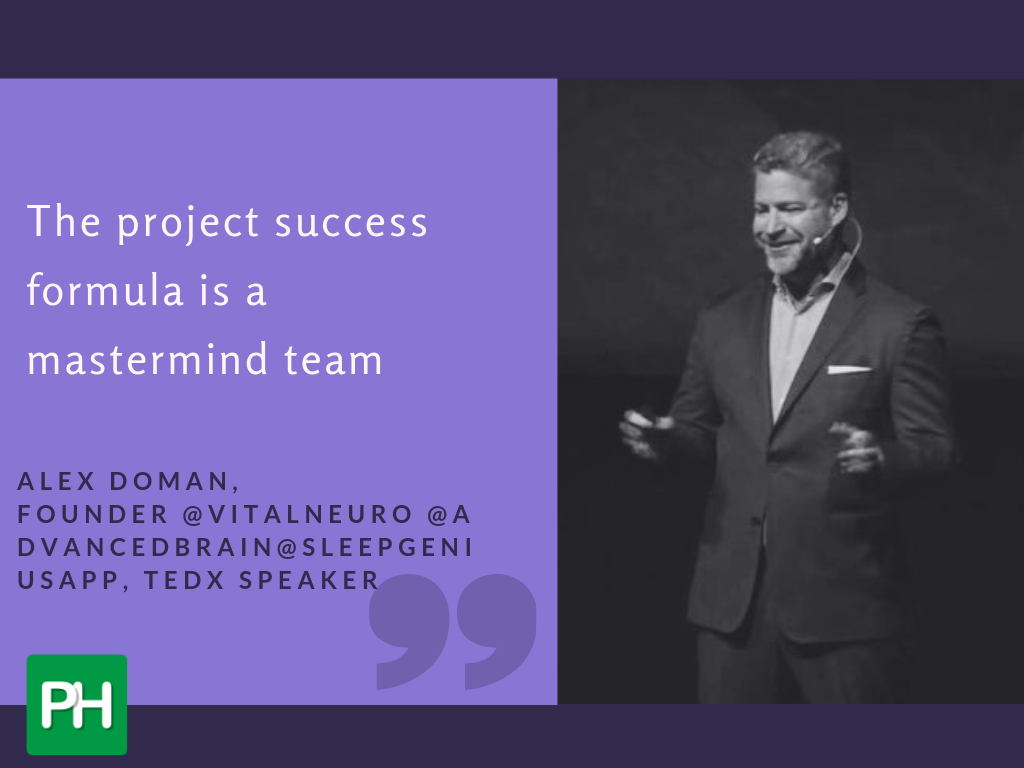
Alex Doman is an author, entrepreneur, public speaker, music producer and product creator, who has 25 years of experience in leadership in the brain health, neurotechnology, and therapeutic music markets.
His views:
To ideate and execute a project, it helps to step back to the basics, and take note of the example set by innovators like Henry Ford, Thomas Edison, and Charles Schwab. After studying these and other successful visionaries author Napoleon Hill articulated a concept to stop projects from failing before they even begin, the mastermind group.
Early in my career, I absorbed this and other ideas through business, psychology, and personal development studies. It was not until recently I came to the realization that building mastermind groups, formed the bedrock of my entrepreneurial path. In 25 years of creating neurotechnology products and companies, one thing has become patently clear. We need collaboration for projects to succeed.
The project success formula is a mastermind team. A group of people who show mutual respect for everyone at the table, and honestly care about the results the project will produce. This collective begins with the end in mind. They focus on a goal with laser sharp vision and create an actionable plan to achieve it. Roles and responsibilities are assigned, resources allocated, deadlines set, and interdependencies identified. With complete transparency, trust is established and each team member is held accountable for their contributions by the collective. Online project management tools are essential, especially for distributed teams.
For a mastermind to work, identify and invite collaborative subject matter experts who agree to focus on the mission and benefits the project will produce. Egos are checked at the door. There must be an environment of respect and trust. Without, there is no basis for collaboration and your project will have one guaranteed outcome, failure.
And, with a unified vision, and an atmosphere of trust, great things will come. Like mass production lines, incandescent light, and brokerage services to individual investors.
16. Igor Rutsky talks about having a robust strategy
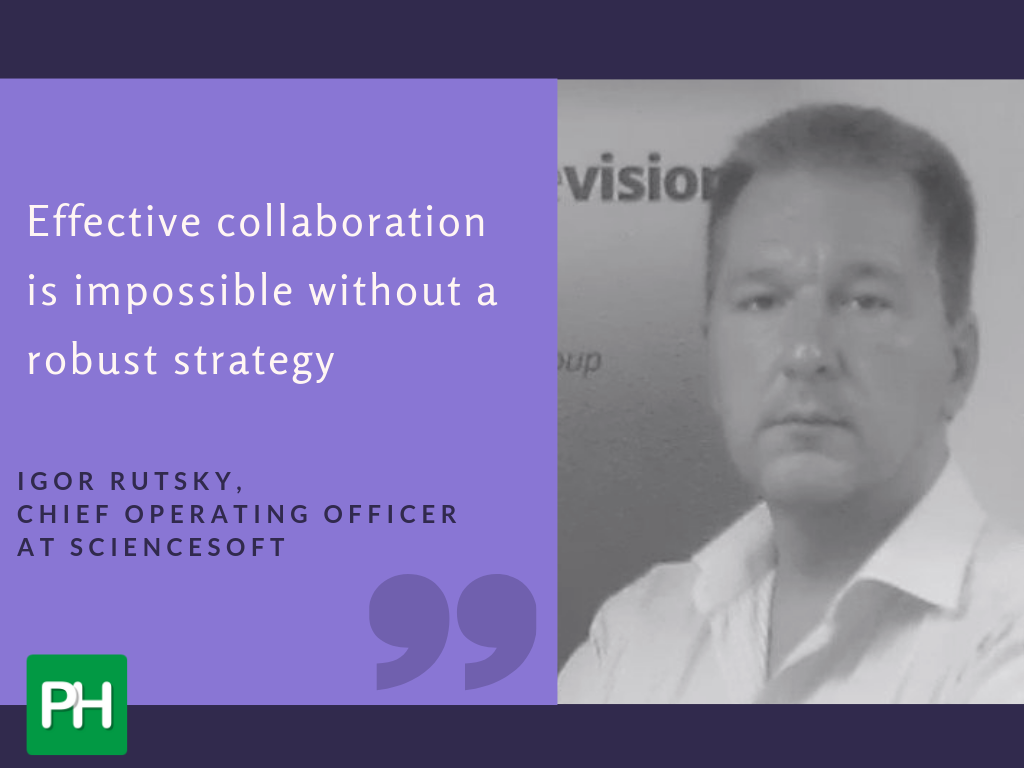
Igor Rutsky joined ScienceSoft, an IT consulting and custom software development company, as an IoT and AI Project Manager. Now Igor is the company’s COO.
He says:
The success of a project depends on the effectiveness of collaboration between team members who are working on it. Effective collaboration is impossible without a robust strategy that should be considered from both organizational and technology points of view. Thus, I believe a robust team collaboration strategy should consist of the following 3 components:
- Setting clear goals and responsibilities: A team should understand their individual goals under a project as well as realize the full picture. Also, the responsibilities of team members in the collaboration environment should be clearly defined. That said, it’s important to review project roles and encourage people to take new responsibilities and develop their professional expertise, which also brings value to collaboration efficiency.
- Creating a supportive collaboration environment: Collaboration should be supported at both the team level and at the company level. Team members should be encouraged to freely share their ideas on a project.
As for the company level, managers and executives should nurture the collaboration culture, which should be one of the key organization’s trends. For example, an organization can initiate employee training on how to collaborate effectively.
- Choosing proper collaboration tools: The way of organizing working processes is crucial to the success of team collaboration. Usually, an online project management solution is the right choice as it can address the needs of teams located in different places and time zones. It helps to track the progress of each team member and the whole team in real time and timely detect issues that may hinder a project’s fulfillment. A project management software also makes all the necessary materials and files accessible within the collaboration environment created specifically for a team or a project, like a project site.
We hope you enjoyed reading what the experts had to say about their one team collaboration strategy that helps their projects from falling. While some people believe in having a tool, some believe in setting clear goals and responsibilities, and some may also believe in both.
What is one steam collaboration strategy that helps your projects from failing?
